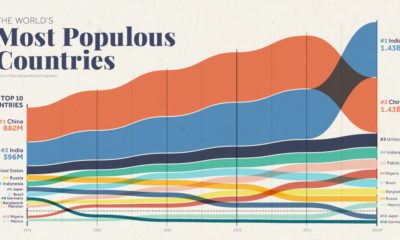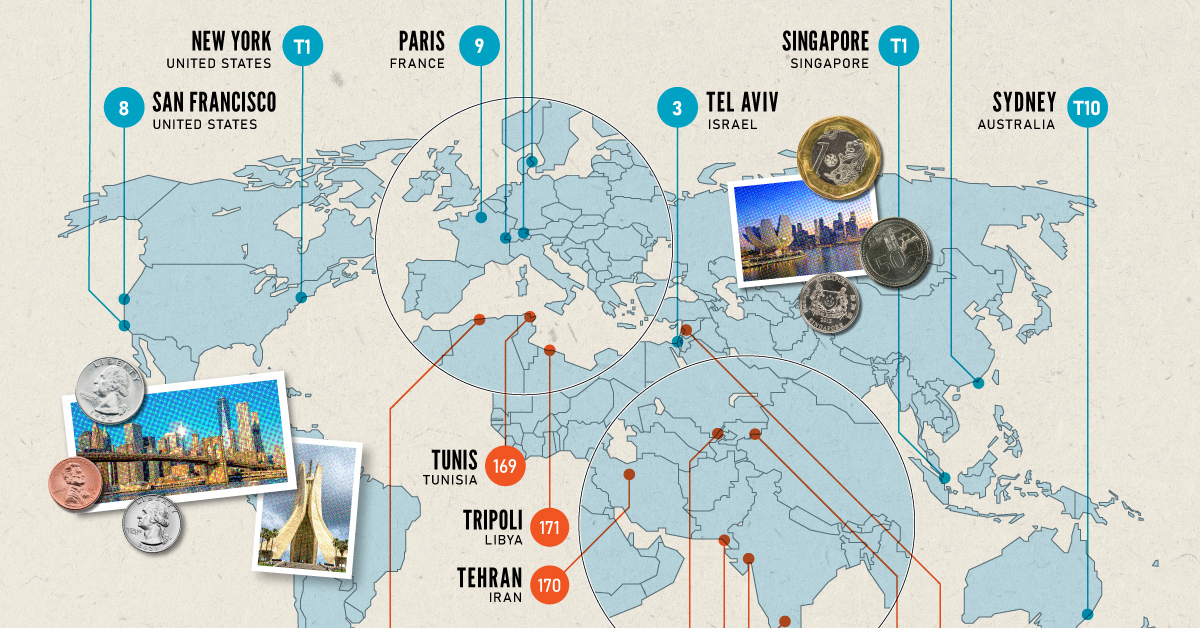Rapid urbanization is one of the major forces shaping our global economic future. A century ago, it was almost unfathomable that any person would want to live in a city with 10 million other people, but by the 1930s, New York City was the first metropolitan area to pass the mark. Fast forward to today, and there are 33 urban areas that meet the definition of a “megacity” spread throughout the globe. It’s true that many of these megacities have been global centers for a long time – think cities like London, Tokyo, Los Angeles, and Paris – but we are now entering an era in which new megacities are cropping up every other year, including ones that have less familiar names and backstories.
The Megacity Landscape
Today’s chart is based on a forecast from Euromonitor International, outlining how the megacity landscape will shift in the coming years. It focuses on the 39 megacities expected by the year 2030, when they will house 9% of the global population and contribute 15% of the world’s GDP. These same megacities will take up about 3% of global land mass.
New Megacities by 2030
Just over a decade from today, there will be five new megacities in developing countries, and one from a developed market: Chicago The Windy City has been on the cusp of the megacity mark for some time, and it will finally hit 10 million inhabitants in the coming years. In 2030, it will have by far the biggest GDP of all new megacities, at $596 billion (constant 2017 prices). Bogotá The high-altitude Colombian capital will join the ranks of other Latin American megacities like Rio de Janeiro, São Paulo, Mexico City, Lima, and Buenos Aires. It will have a $109 billion economy (constant 2017 prices) by this time. Luanda This is the entry to the list with the fastest-growing population. Between 2017-2030, the city will increase its residents by 60% – but it will still be nowhere as big as Cairo, which will be Africa’s biggest megacity at 29.8 million people. Chennai This city, which is on the Bay of Bengal in eastern India, will be the most dense of all new megacities by 2030. Chennai’s economy, however, will be $50 billion (constant 2017 prices) – which is just 1/12 the size of Chicago’s. Baghdad Iraq’s biggest city already has close to 8 million inhabitants, but by 2030 it will get to the double digits thanks to its impressive population growth rate. Dar es Salaam The most populous city in Tanzania is growing almost as fast as Luanda – and on top of that, it has the fastest-growing (and smallest) GDP of the six new megacities. This isn’t the first time the city’s name has come up in a projection like this, as the Global Cities Institute sees it being the third most populous city in the world further down the line.
Other Projections
What other interesting things are projected to happen to key urban centers?
Jakarta is anticipated to be the biggest megacity of all in 2030 with 35.6 million people Tokyo will fall from the top spot, as an aging population translates to negative population growth Osaka will be the oldest megacity with 31% of the population aged 65+ Lagos will be the fastest-growing city overall in the 2017-2030 timeline Roughly a dozen cities will double their economies over this timeframe, led by Dhaka, Manila, and Bangalore
When it comes to global urbanization, the only constant is change – and massive metropolises that seem unfathomable today could be much more commonplace down the road.
on Cities become “expensive” due to a variety of factors such as high demand for housing, a concentration of high-paying businesses and industries, and a high standard of living. Additionally, factors such as taxes, transportation costs, and availability of goods and services can also contribute to the overall cost of living in global cities. The infographic above uses data from EIU to rank the world most and least expensive cities to live in. To make the list, the EIU examines 400+ prices for over 200 products and services in 172 cities, surveying a variety of businesses to track price fluctuations over the last year.
Inflation + Strong Currency = Expensive Cities
If you live in a city where many residents find it challenging to put a roof over their heads, food on their plates, and make ends meet, you live in an expensive city. But if this inflation is compounded with a strong national currency, you may live in one of the world’s most expensive cities. Singapore and New York City tied for the first rank amongst the world’s most expensive cities in 2022, pushing Israel’s Tel Aviv from the first place in 2021 to the third place in 2022. Both these cities had high inflation and a strong currency. Surprisingly, this is the Big Apple’s first time atop the ranking. The city with one of the most expensive real estate markets worldwide, Hong Kong ranked fourth in this list, followed by Los Angeles, which moved up from its ninth rank in 2021.
Poor Economies = Cheaper Cities
Asia continues to dominate the list of the world’s least expensive cities, followed by parts of North Africa and the Middle East. Though affordability sounds good at face value, sitting at the bottom of the ranking isn’t necessarily a coveted position. While the cost of living in some of the cities in these nations is low, it comes at the price of a weak currency, poor economy, and, in many cases, political and economic turmoil. The decade-long conflict in Syria weakened the Syrian pound, led to a spiraling inflation and fuel shortages, and further collapsed its economy. It’s no surprise that its capital city of Damascus has maintained its position as the world’s cheapest city. Tripoli and Tehran, the capitals of Libya and Iran, respectively, follow next on this list, reflecting their weakened economies. Meanwhile, seven cities in Asia with the common denominator of high-income inequality and low wages dominate the list of the world’s cheapest cities. These include three Indian cities, Tashkent in Uzbekistan, Almaty in Kazakhstan, Pakistan’s most populous city of Karachi, and Sri Lankan capital–Colombo.












